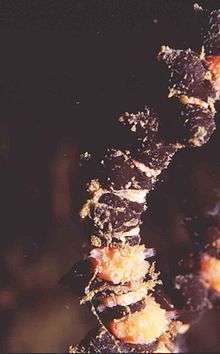Sepia vermiculata
Sepia vermicularis, the patchwork cuttlefish.sometimes known as the common cuttlefish or ink-fish in South Africa, but the name common cuttlefish is more widely applied to Sepia officinalis. It is endemic to southern Africa.
| Sepia vermiculata | |
|---|---|
| Scientific classification | |
| Kingdom: | Animalia |
| Phylum: | Mollusca |
| Class: | Cephalopoda |
| Order: | Sepiida |
| Family: | Sepiidae |
| Genus: | Sepia |
| Subgenus: | Sepia |
| Species: | S. vermiculata |
| Binomial name | |
| Sepia vermiculata | |
Distribution
This cuttlefish is found around the South African coast from Saldanha Bay to Algoa Bay, subtidally to at least 40m.[3]Outside South Africa its range extends to central Mozambique and on the Saya-de-Malha Bank and the Indian Ocean islands of the Seychelles, Mauritius and Rodrigues.[4][1]
Description
The South African common cuttlefish has an elongated body with ten arms bearing rows of suckers. Two arms are elongated tentacles used for catching prey. Paired lateral fins extend the whole length of the body. The upper surface of the body is smooth, with rippling bars of colour and the animal is usually well camouflaged.
Ecology

This animal lives on reefs and feeds on shrimp and small fishes. A gas-filled internal shell is used for buoyancy. The eggs are pea-like and black or white and are usually seen attached to sea fans. The animal is capable of rapid changes of colour for camouflage, threat displays or for communicating mating readiness. A male ready to mate will show dark brightly rippling colours as he approaches another cuttlefish. If the other cuttlefish is either a male cuttlefish or a non-receptive female, the other cuttlefish will also show dark brightly rippling colours as a threat display. If the other cuttlefish is a receptive female, her colours will remain pale and head-to-head mating will take place.[5] It may also lift two arms above its head when disturbed, possibly as threat gesture.
It is the only southern African species of cuttlefish to enter lagoons and estuaries having being recorded in Langebaan Lagoon and Knysna Lagoon as well as the mouth of the Kowie River[4]
References
- Barratt, I. & Allcock, L. (2012). "Sepia vermiculata". IUCN Red List of Threatened Species. 2012: e.T162619A930233. doi:10.2305/IUCN.UK.2012-1.RLTS.T162619A930233.en. Retrieved 20 February 2018.
- Julian Finn (2016). "Sepia vermiculata Quoy & Gaimard, 1832". World Register of Marine Species. Flanders Marine Institute. Retrieved 20 February 2018.
- Branch, G.M. Griffiths, C.L. Branch, M.L. Beckley, L.E. 2000 Two Oceans: A guide to the marine life of southern Africa. ISBN 0-86486-250-4
- P. Jereb; C.F.E. Roper, eds. (2005). Cephalopods of the World an Annotated and Illustrated Catalogue of Cephalopod Species Known to Date Volume 1 Chambered Nautiluses and Sepioids (Nautilidae, Sepiidae, Sepiolidae, Sepiadariidae, Idiosepiidae and Spirulidae). Food and Agriculture Organization Rome. pp. 124–125. ISBN 92-5-105383-9.
- Branch G. and Branch, M. 1995. The Living Shores of southern Africa ISBN 0-86977-115-9
